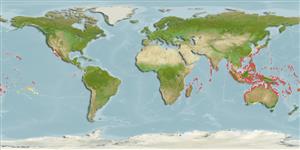Environment: milieu / climate zone / rango de profundidad / distribution range
Ecología
marino asociado a arrecife; rango de profundidad 8 - 20 m (Ref. 9710). Tropical; 35°N - 35°S
Indo-Pacific: East Africa to Samoa, north to southern Japan, south to New South Wales and Tonga.
Tamaño / Peso / Age
Madurez: Lm ? range ? - ? cm
Max length : 13.0 cm SL macho / no sexado; (Ref. 48637)
Espinas dorsales (total) : 1 - 2; Radios blandos dorsales (total) : 29 - 34; Espinas anales: 0; Radios blandos anales: 26 - 30. Body and head color variable. Blackish to dark bluish branchial blotch extending dorsally to level well above the lower margin of eye and may include ventrally the pectoral fin base and axil. Iris usually dark brown. Orange to red caudal fin soft dorsal and anal fins clear, orange or yellow with spots; pectorals clear. Scale spinulation at midbody closely packed. Male scale ridge rugosities develop at about 80 mm SL developed. Strong first dorsal spine. Large pelvic fin rudiment narrowly attached to posterior margin of ventral flap.
Body shape (shape guide): short and / or deep; Cross section: compressed.
Occurs in shallow lagoons and seaward reefs to a depth of about 15 m; common in coral-rich areas. Secretive species (Ref. 9710, 48637) among rocks, sponges or in crevices on the bases of large coral formations. Adults usually form pairs but often only one is observed while the other one is hiding (Ref. 48637).
Life cycle and mating behavior
Madurez | Reproducción | Puesta | Huevos | Fecundidad | Larva
Hutchins, J.B., 1986. Review of the monacanthid fish genus Pervagor, with descriptions of two new species. Indo-Pac. Fish. (12):35 p. (Ref. 527)
IUCN Red List Status (Ref. 130435: Version 2025-1)
Threat to humans
Harmless
Human uses
Herramientas
Special reports
Download XML
Fuentes de Internet
Estimates based on models
Preferred temperature (Referencia
123201): 23.7 - 29.2, mean 28.1 °C (based on 2532 cells).
Phylogenetic diversity index (Referencia
82804): PD
50 = 0.5039 [Uniqueness, from 0.5 = low to 2.0 = high].
Bayesian length-weight: a=0.01995 (0.01135 - 0.03508), b=2.93 (2.77 - 3.09), in cm total length, based on LWR estimates for this species & (Sub)family-body (Ref.
93245).
Nivel trófico (Referencia
69278): 2.9 ±0.4 se; based on size and trophs of closest relatives
Resiliencia (Referencia
120179): Alto, población duplicada en un tiempo mínimo inferior a 15 meses (Preliminary K or Fecundity.).
Fishing Vulnerability (Ref.
59153): Low vulnerability (10 of 100).
🛈
Nutrients (Ref.
124155): Calcium = 77.8 [33.2, 197.0] mg/100g; Iron = 0.798 [0.360, 1.897] mg/100g; Protein = 17.9 [15.6, 20.1] %; Omega3 = 0.105 [0.049, 0.217] g/100g; Selenium = 25.1 [11.9, 58.5] μg/100g; VitaminA = 80.3 [22.1, 293.9] μg/100g; Zinc = 1.66 [1.06, 2.64] mg/100g (wet weight);
